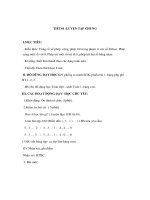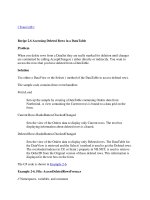Tài liệu Unit 1- What is a computer? pptx
Bạn đang xem bản rút gọn của tài liệu. Xem và tải ngay bản đầy đủ của tài liệu tại đây (91.61 KB, 4 trang )
Lan Anh Nguyen/ ESP/HNUE
1
Unit 1
What is a computer?
When you read the following text, you will probably meet words and expressions that are
new to you. First try to understand their meaning from the context – read the same passage a
few times. When you have read the whole text, check new words in a dictionary.
A computer is a machine with an intricate network of
electronic circuits(Điện xoay chiều?)
that(1) (
!computer) operate switches or magnetize tiny metal cores. The switches (nút?),
like the cores, are capable of being in one of two possible states, that is, on or off,
magnetized or demagnetized. The machine is capable of storing and manipulating numbers,
letters, and characters. The basic idea of a computer is that we can make the machine do what
we want by inputting signals that turn certain switches on and turn other off, or that
magnetize or do not magnetize the cores.
The basic job of computers is the processing (xử lí?) of information. For this reason,
computer can be defined as devices (thiết bị?) which(2) (
!devices) accept information in the
form of instructions called a program and characters called data, perform mathematical
and/or logical operations on the information, and then supply results of these operations. The
program, or part of it(3), which(4) tells the computers what to do and the data, which provide
the information needed to solve the problem, are kept inside the computer in a place called
memory.
Computers are thought to have many remarkable powers. However, most computers, whether
large or small have three basic capabilities. First, computers have circuits (mạch) for
performing arithmetic (số học) operations (các thao tác), such as: addition, subtraction,
division, multiplication and exponentiation. Second, computers have a means of
communicating with the user. After all, if we couldn’t need information in and get results
back, these machines wouldn’t be of much use. However, certain computers (Commonly
minicomputers and microcomputers) are used to control directly things such as robots,
aircraft navigation systems, medical instruments, etc.
Some of the most common methods of inputting information are to use punched cards,
magnetic tape, disks, and terminal. The computer’s input device (which might be a card
reader, a tape drive or dirk drive, depending on the medium used in inputting information)
reads the information into the computer.
For outputting information, two common devices used are a printer which(5) prints the new
information on paper, or a CRT display screen which(6) shows the results on a TV-like
screen.
Third, computers have circuits which(7) can make decisions. The kinds of decisions which
computer circuits can make are not of the tape: “Who would win a war between two
Lan Anh Nguyen/ ESP/HNUE
2
countries?” or “Who is the richest person in the world?”. Unfortunately, the computer can
only decide three things, namely: Is one number less than another? Are two numbers equal?
And, is one number greater than another?
A computer can solve a series of problems and make hundreds, even thousands, of logical
decisions without becoming tired or bored. It(8) can find the solution to a problem in a
fraction of the time it takes a human being to do the job. A computer can replace people in
dull, routine tasks, but it(9) has no originality; it works according to the instructions given to
it and cannot exercise any value judgments. There are times when a computer seems to
operate like a mechanical “brain”, but its achievements are limited by the minds of human
beings. A computer cannot do anything unless a person tells it(10) what to do and gives it the
appropriate information; but because electric pulses can move at the speed of light, a
computer can carry out vast numbers of arithmetic-logical operations almost instantaneously.
A person can do everything a computer can do, but in many cases that person would be dead
long before the job was finished.
Words and expressions
circuit
core
device
program
data
memory
punched card
magnetic tape
disk
terminal
input device
tape drive
disk drive
CRT display
instruction
Exercises
I. Main idea
Which statement best expresses the main idea of the text? Why did you eliminate the other
choices?
1. Computers have changed the way in which many kinds of jobs are done.
2. Instructions and data must be given to the computer to act on.
3. Computers are machines capable of processing and outputting data.
4. Without computers, many tasks, would take much longer to do.
II. Understanding the passage
Decide whether the following statements are true or false (T/F) by referring to the
information in the text. Then make the necessary changes so that the false statement
become true.
1. A computer can store or handle any data even if it hasn’t received information to do so.
2. All computers accept and process information in the form of instructions and
characters.
3. The information necessary for solving problems is found in the memory of the
computer.
Lan Anh Nguyen/ ESP/HNUE
3
4. Not all computers can perform arithmetic operations, make decisions, and communicate
in some way with the user.
5. Computers can still be useful machines even if they can’t communicate with the user.
6. There are many different devices used for feeding information into a computer
7. There aren’t as many different types of devices used for giving results as there are for
accepting information.
8. Computers can make any type of decision they are asked to
9. Computers can work endlessly without having to stop to rest unless there is a
breakdown.
III. Locating information
Find the passage in the text where the following ideas are expressed. Give line references
as in the example below.
1. Computers accept information, perform mathematical and/or logical operations then
supply new information.
2. All computers have three basic capabilities.
3. A computer is a machine that can be made to operate by receiving signals.
4. A computer cannot work without being told what to do.
5. A computer can make three types of decisions.
6. The fundamental job of a computer is processing information.
7. A computer can do the work of hundreds of people in a very short time.
8. The memory of a computer is used for storing information.
IV. Understanding words
Refer back to the text and find
synonyms for the following words.
Refer back to the text and find
antonyms for the following words
1. complex _________
2. fundamental _________
3. away _________
4. uninterested _________
5. accomplishments _________
6. large _________
7. receiving _________
8. reject _________
9.
unusual _________
10. small _________
V. Content review
Try to think of a definition for each of these items before checking them in the Glossary.
Then complete the following statements with the appropriate words. (Some can be used
more than once). Make sure you use the correct form, i.e. singular or plural.
core device data circuit terminal switch
program memory medium CRT display
1. Every computer has _________ for performing arithmetic operations,
operating_________ or magnetized _________.
2. A _________ with a screen is normally referred to as a _________ unit.
3. A computer is a _________ that processes information in the form of _________ and
_________ and can store this information an a _________.
Lan Anh Nguyen/ ESP/HNUE
4
4. Card readers, tape drives, or disk drivers are different _________ for inputting
information.
Focus a
Contextual reference
Exercise 1
What do the following underlined words refer to?
Computers are electronic machines
that process information. They are capable of
communicating with the user, of doing different kinds of arithmetic operations and of
making three kinds of decisions. However,
they are incapable of thinking. They accept
data and instructions as input, and after processing
it, they output the results.
When talking about computers, both hardware and software need to be considered. The
former refers to the actual machinery, whereas the latter refers to the programs which
control and coordinate the activities of the hardware while processing the data.
The first computer was built in 1930 but since then computer technology has evolved a
great deal. There are three different kinds of computers in use today: the mainframe, the
minicomputer and the microcomputer.
These all have one thing in common: they operate
quickly and accurately in solving problems.
Exercise 2
Now look back at the text and find out what the words in bold typeface refer to:
1. that
2. which
3. it
4. which
5. which
6. which
7. which
8. it
9. it
10. it









